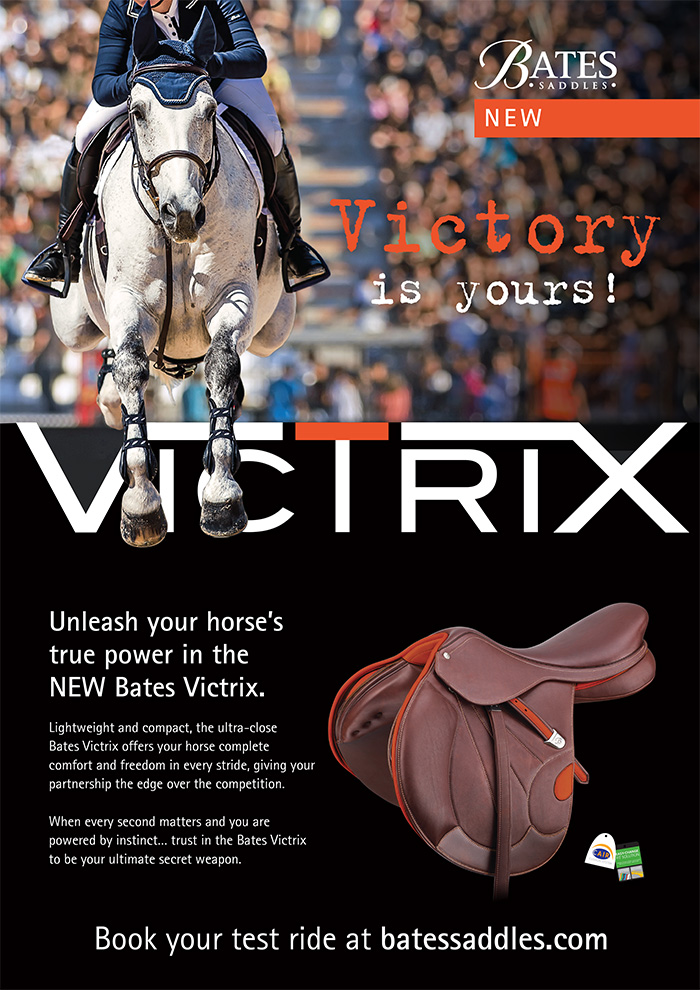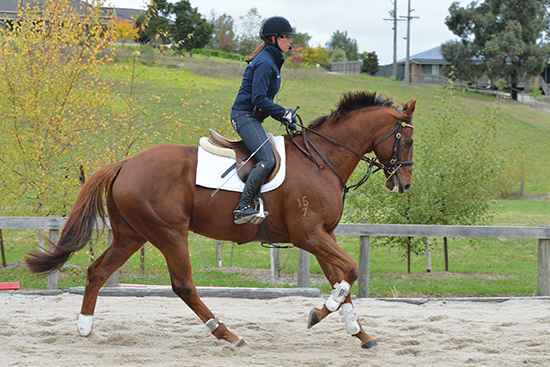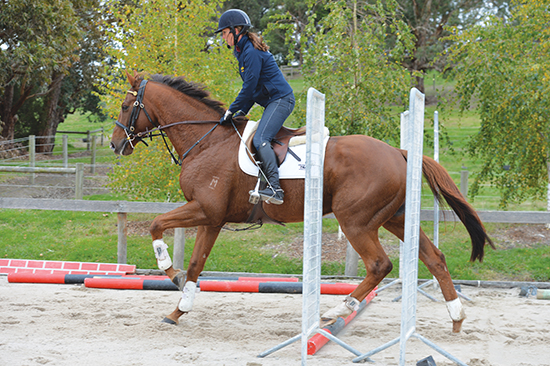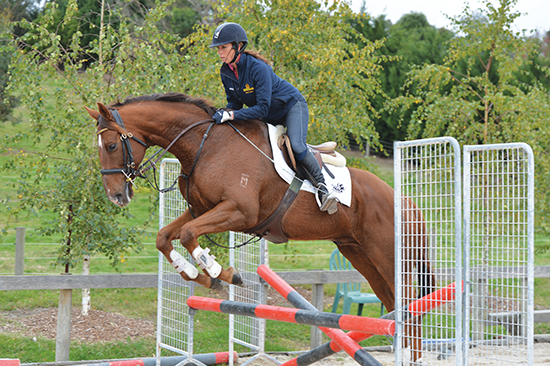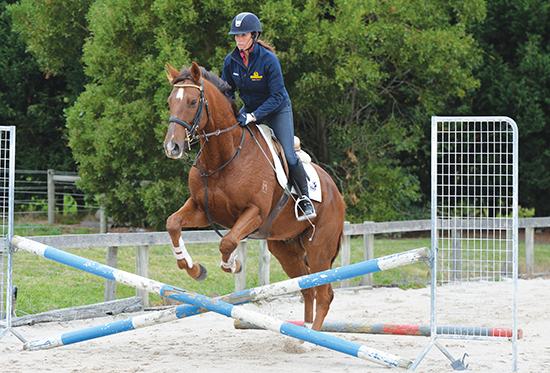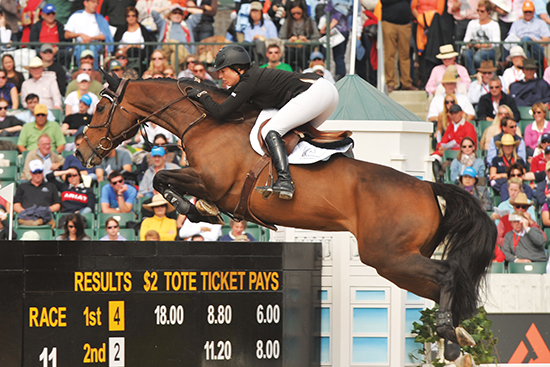View part one here: http://www.horsemagazine.com/thm/2015/08/re-training-the-off-the-track-thoroughbred-as-a-jumper/
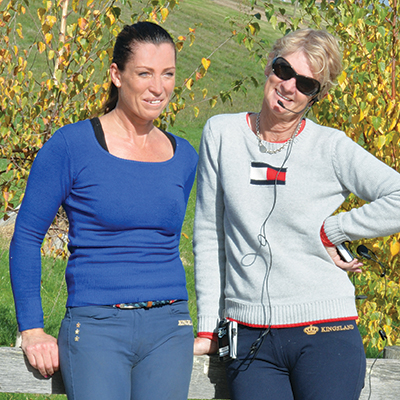 With Caroline Price and Michelle Strapp
With Caroline Price and Michelle Strapp
Words by Chris Hector & Photos by Roz Neave
In part two of our racetrack to showjump arena feature, with King Usain and Caroline Price, Caroline’s trainer, Michelle Strapp talks about the rôle of the Thoroughbred in today’s showjumping world… and their advantages!
“All these Thoroughbreds that come off the track, if you take your time and you produce them and have them traveling well, it is opening the market for people who can’t buy the expensive horses. Perhaps it’s time to bring the Thoroughbred back in – there used to being many many Thoroughbreds competing in jumping, and to the highest level, even when they weren’t properly trained. Look at this horse, if you got him traveling a little longer and lower, you would add so much scope and stride, and that is just training. He is a lovely type.”
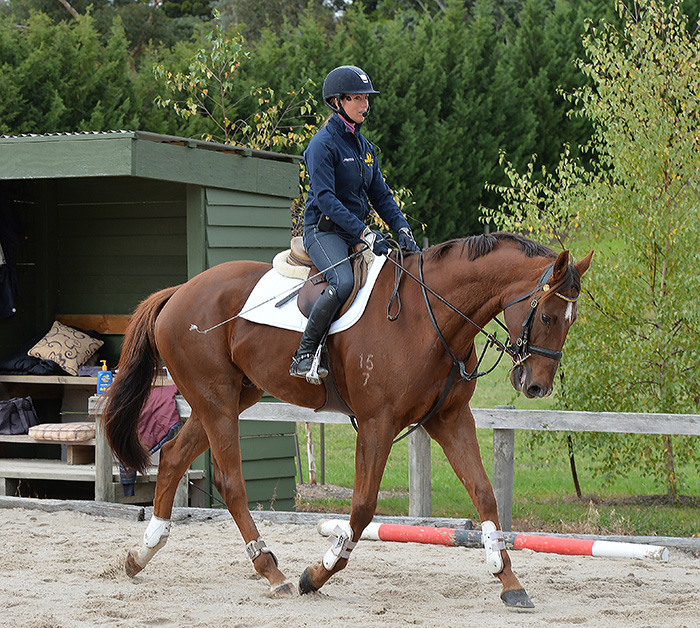
What to aim for: “if you got him traveling a little longer and lower, you would add so much scope and stride, and that is just training.”
“When you look at two horses in an arena, on one side the big Warmblood that finds it hard to be short and quick, but has a power jump, or you have the beautiful Thoroughbred that finds it easy to be short and quick, and if you can just get that Thoroughbred to use its body more – get over its past – one is definitely the easiest to ride, one is definitely the more athletic, and that’s the good Thoroughbred. The good ones have that extra leg under them, they are very quick to be able to take that extra distance, they can use the back.”
“There are some Thoroughbreds that are tight in the back, I’m working with one now, it finds it difficult to use the back over a fence, but my student has worked hard and now it is actually traveling longer and lower, starting to travel really nicely. At first it had no idea how to get its legs over a jump, and now it is starting to swing, can soften and jump into the hand, and it is actually starting to jump, the rider is trying to give it every opportunity. It may make a horse, but its past might have been too stressful for it to recover. For some their past will always get in their way of progress.” While Caroline and Michelle have been talking King Usain has got a little restive, tossing his head, backing out of the contact.
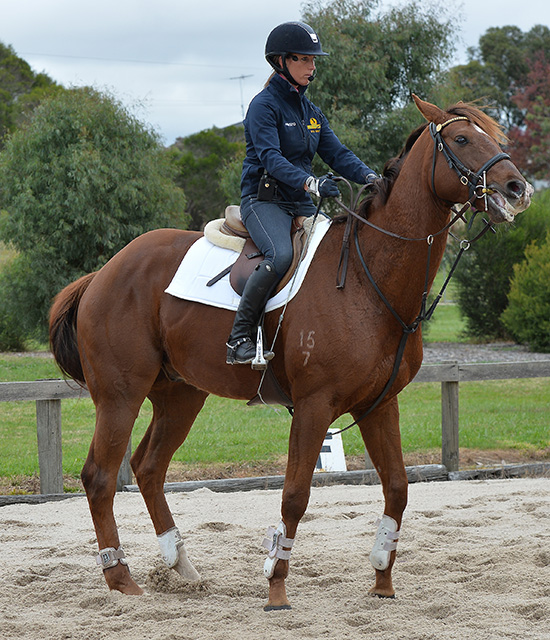
“No,” says Michelle, “Stand still, but keep the feel, don’t let him step back, block the little reef of the reins, then as he can’t cope any more, walk forward to the bit. Just gently, this work is important, because that is going to be the reaction he gives when he goes down a line and he wants to run, teach him to go into the bridle. Stand still again, and as soon as he goes to reef, walk forward to it, walk forward to it.
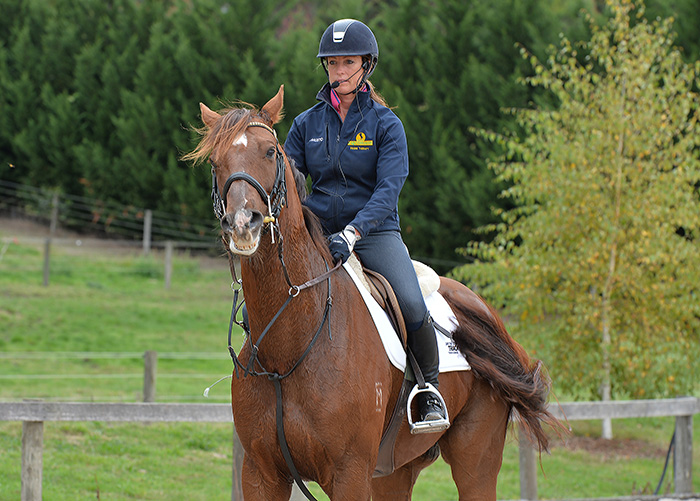
Quietly make him step to the bit all the time. In a sense you are mouthing him, always you are trying to improve the quality of his reception to your hand. If they stand there reefing at your hand, then that is the reception they have to the hand. One thing about training is consistency, you have to be really consistent.”
“Some people can’t do what you are doing because their contact is too brittle. If you can do what you are doing with a mouth that is so green, that means you have an elastic feel from your shoulders, your elbow, your hand, to the bit. It all becomes an extension. You see a lot of Thoroughbreds, when they jump through the air they are inverted, they don’t take the rein, and of course back rails are going to look a lot further away. If you get a horse that actually takes the rein because of your contact, off the floor and jumps from a contact, that’s when you will get the jump you want.”
more on contact follows
| “A lot of Thoroughbreds won’t jump from a contact, they actually stop in the air because they stop at the contact, they are scared of the hand. That’s the scary thing about the training out there, people just ride off the front, it’s a human thing, they just want to ride off the front. A Thoroughbred gets hot and fast, so riders do abrupt halts, rein backs, and then the Thoroughbred doesn’t want to step into the contact, they become bouncy and inverted and don’t want to use their scope.” |
“The thing about feel is that in a way, you are always convincing the horse that there isn’t a contact, when there is a contact, because what the horse has to believe is that it can keep going forward even when someone has hold of the corners of its mouth. That means a horse has to feel very comfortable about what he feels in the corners of his mouth. That’s what creates a horse that is through. But if the horse always stops at the bit, he’s brittle, then the horse will always break into two halves.”
“You want the horse to come to the contact and step through the bridle, and that makes a difference off the floor (when the horse takes off in front of a fence). If you get a horse like this – who has natural spring, natural activity – to do this, then you can get them to use their scope. If you land and you’ve got a big combination, you don’t want it bringing its neck back at you, you don’t want it landing and dropping the bit and inverting because then you are not going to make the back rail of the next fence in the combination.”
“Teaching good contact is one of the hardest things of all, and I find the best way to teach it, is through half transitions. Then I get students reading what is happening behind them, and that always delivers a contact that is true. The misunderstanding is so widespread, you see riders pulling hard on the inside rein and saying ‘my horse is hanging on the inside rein’, they pull to the inside: it’s like having an elastic band, they pull, it twangs back, they pull, it twangs back. If they don’t do anything with the horse’s body, the contact will never change. The horse is 60% on the forehand anyway. Teaching elastic contact is a very difficult thing, but the way to do it is taking the emphasis off the hand, and onto just keeping a nice straight line, emphasizing – bit, hand, elbow, so the hand doesn’t lock up and try to follow the contact, and to think about what the whole horse is doing, and none of this zig zag in hands, pulling reins to the inside, to the outside. The way is to get the rider working on the horse’s whole body.”
“A lot of the kids I am teaching now, when they first come it is zig zag zig zag with the reins, because they have no leg, and they are trying to get their ponies’ heads down. So we work on straight lines and starting to feel what the horses four corners are doing, how the horse feels under them, things they need to feel, rather than what they can see. So the first Pony Club dressage test these kids go to, they are crucified by the judge – ‘your pony is not round enough!’ What chance have you got? Not that they are traveling in a nice rhythm, or that they are accurate – get his head down!”
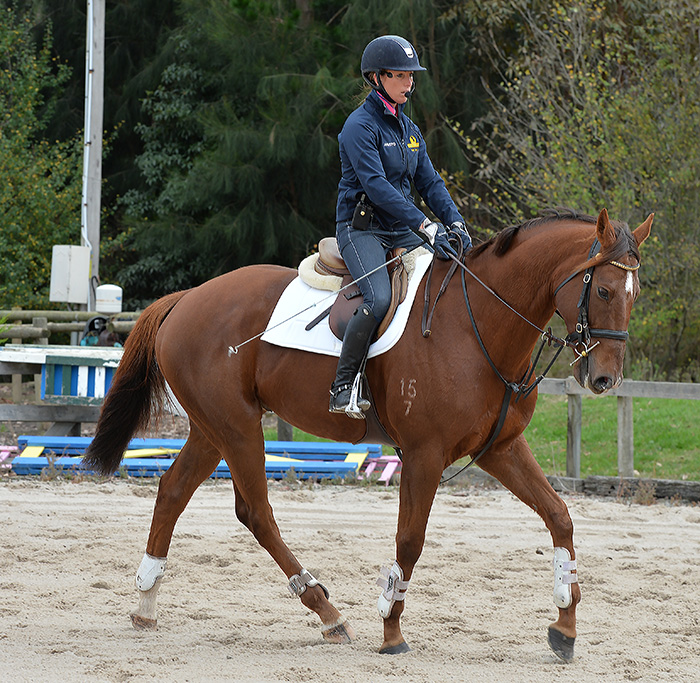
Look at this horse trying to come onto the bit…
“But Caroline is making him feel good, she is going to stay nice and relaxed in her elbow, her hand becomes an elastic feel to the horse’s mouth. What she is doing now is really important stuff, because she is producing the bridle. That is what is going to make or break a horse – the feel to the bridle. She has a good balance between hand and leg, so that when it hits the bridle she just does enough to put it back to the bridle, she doesn’t over-react with leg.
I say it, and say it again, it’s one of George Morris’ favorite sayings: ‘Too much leg, creates too much hand – too much hand, creates too much leg.’”
“I rode a girl’s horse yesterday, and it really wouldn’t go. And she said, ‘its mouth is really hard and it will not go forward’, I got on it and said, I hate to tell you but this mouth is not hard. But if you tighten your elbows and put on the lock, then you’ve got the hand-brake on. You’ve got a motor, you’ve got a wonderful engine, and if the engine goes to something that it doesn’t like, why would it go? That’s why you see a lot of horses resisting, with their ears back, because what are they going to go to? Pain? That’s not logical.”
“When Caroline lands after the exercise, she works on the canter, works on the balance. You are trying to find a nice easy canter down there.”
“At the moment, we’ve just got a trot fence first, and five canter strides to a small fence in a straight line, nice and simple. We want to give the horse the simple concept of getting from one side of the fence to the other. As we chip away at the education, we want to find out what the horse’s jump is like, what is its desire like, does it naturally want to jump, is it athletic enough? He just trots in, canters forward, pops over the small fence. We just want a nice simple distance between the two fences, so Caroline finds it easy, ideally Caroline does not want to have to produce a canter above the horse’s level of education. At first they have no idea of how to get from one side to the other, we have to let them learn, let him make mistakes at the fence and learn.”
“Because his canter is so natural, Caroline, watch that you don’t just stay over him and accept it. Try and come back, try and work the canter after you have jumped. Little transitions all the time. It is nice that you have a horse with such a nice canter and you can just sit there, but keep educating the balance of it, so when he feels you come back, he starts to balance. He goes in that canter, and then he comes off the bridle. It’s like when you were walking, you are always trying to ride him to a feel. Really his contact has improved a lot already.”
“This is not hassling him. If he was a hotter horse, we’d reverse it and jump away from home, but also Caroline helps, because her balance is good through the air, she doesn’t throw her body ahead of the motion, so that doesn’t make him quick. He’s nice, he’s got a natural bascule about his jump and natural spring. I like cross oxers, crosses all the time, but he is a fast learner.”
“When you do the first jump with a Thoroughbred off the track, they are startled, oh my god look at that, then all of a sudden they become a little brave, a bit cocky, and forget about the job. Your job is just to get him down there in a nice form, and let him work it out. But then land and educate, take your time until settles before going to the fence again.”
“When you see a horse like this, you see that Thoroughbred quality, light off the floor, they land light, they have a lightness about them and that is a big advantage, you are not landing and having to try and pick them up. They have that natural quality. He’s had two weeks work this horse – he’s just come in from racing, over thirty starts, half a dozen wins. How nice could he be if you had him as an unbroken two-year-old?”
“If you had a stable of horses, then you’d say, this one gets to stay for another month, he has already shown us enough today…”
“I like the crosses for young horses because it helps to keep the jump straight. All that will get better with the flat, but it is good to introduce the jump. Horses are very expensive and they are very expensive to keep, so if the jump isn’t introduced in a nice way at home, you can’t find out if the horse is worth continuing with. He has a lot of lovely qualities, but he has to show something in the jump as well.”
Next we talk to Greg Best, a fan of the Thoroughbred.
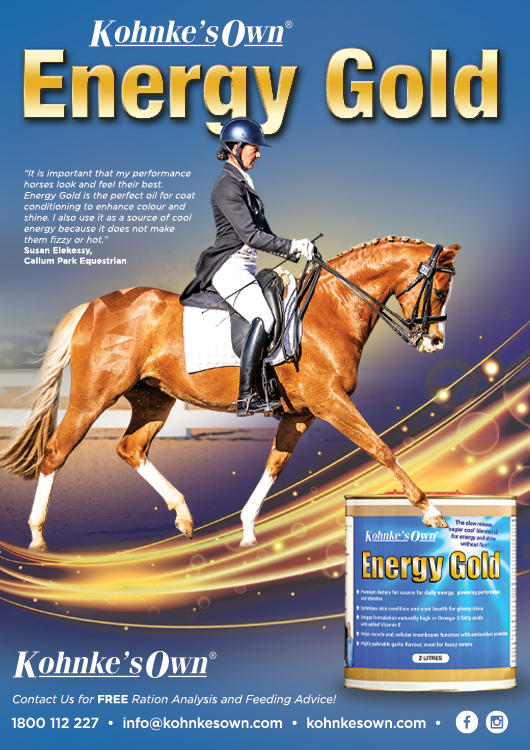
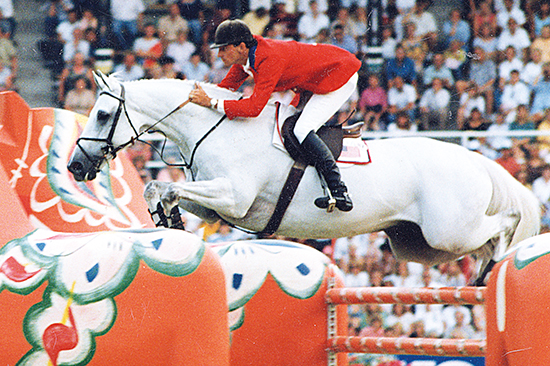 New Zealand based US jumping star, Greg Best was probably the last person to really star at an international level with a Thoroughbred horse – Gem Twist – who was the most successful jumper at the 1990 WEG in Stockholm, but even Greg thinks that the day of the full Thoroughbred has perhaps gone because of the direction the breeders have taken:
New Zealand based US jumping star, Greg Best was probably the last person to really star at an international level with a Thoroughbred horse – Gem Twist – who was the most successful jumper at the 1990 WEG in Stockholm, but even Greg thinks that the day of the full Thoroughbred has perhaps gone because of the direction the breeders have taken:
“Unfortunately I think that the days are gone of the Thoroughbred coming off the track, there’s a few of them out there, but all of these at Jumping with the Stars, most of them here were purpose-bred horses. Unfortunately nobody is out there breeding Thoroughbreds to be showjumpers.”
Still when he judged at Jumping with the Stars, Greg found plenty of Thoroughbred quality in his line up:
“Look at the lovely 5-year-old who won that’s as Thoroughbredy a Warmblood as you’re going to get. He’s got that very leggy, light, super animated way about him, that’s a Warmblood trapped inside of a Thoroughbred body. For obvious reasons I’m very biased towards Thoroughbreds, obviously. I still love them.”
Surely we’re lucky here and in New Zealand in that we still do have the sorts of Thoroughbreds that the German breeders would give eye teeth for in their brood mare band. It wasn’t just Grosvenor – there were horses out of mares by Brilliant Invader, Balmoral Boy, Family Ties, Naturalism, King Tristram, No Mercy…
“Look at Delphi, the horse Katie McVean rode at the WEG. She is out of a Brilliant Invader Thoroughbred mare, by a Holsteiner stallion, and Delphi is probably one of the nicest mares in the world. So yes I think we are so lucky…”
Breeding a jumper? Check out the bloodlines available from International Horse Breeders – www.ihb.com.au
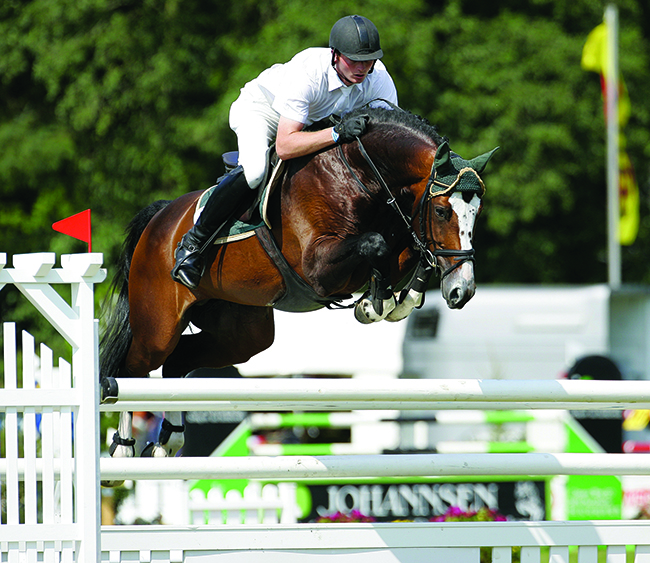
Balou du Rouet


